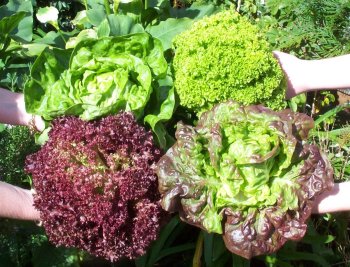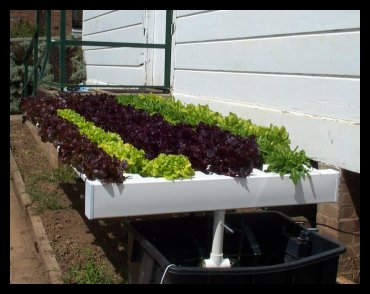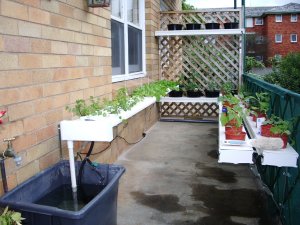Why Hydroponics?The simple answer: no dirt, no digging, no weeds and no diseases! Of course there's a much longer answer which entails a little history and a little science... so here we go.
Most people think that hydroponics is all relatively new, a product of modern science, when in fact the basic techniques can be found in the ancient world. Modern science has perfected those techniques into a succesful form of commercial
By combining two Greek words 'hydro' and 'ponics' (literally 'water' and 'working'), Dr. William F. Gericke of the University of California named his research into the agricultural application of water and plant nutrients in the late 1920's and 30's, and the name has persisted to the present. Now hydroponics is generally accepted to refer to any way of growing plants without soil and can be associated with a number of growing media, like rockwool, perlite or even sand, in fact anything which can help support the plant and conduct the nutrient rich solution to the roots. The advantages of hydroponic growing over soil based are broadly the absence of soil borne pathogens and weeds, and the faster maturation of the plants when nutrient levels are optimal. With the addition of artificial lighting, many more crops can be harvested each year with better yields and much less reliance on chemical pesticides and soil treatments.

The hydroponic nutrient includes various mineral salts such as, nitrogen, potassium, calcium,
phosphorus and magnesium these are known as macro mineral elements, as well as all the micro mineral elements needed for healthy plant growth. All the elements that are used in hydroponics are technical grade minerals which are extracted from the earth and refined to a highly soluble state.
|
Hydroponics at homeJust about any type of food can be grown hydroponically at home, (except for mushrooms!) and the results show that such food is more nutritious and keeps better than soil produced food. Hydroponics can also be used to grow indoor ornamentals, both in the home and the office. Indoor hydroponics is a means of growing good quality plants in areas where conditions are not suitable for normal horticultural practices. Indoor hydroponic methods are already being practiced in facilities in the arctic and Antarctic regions. Orchid and African violet growers have already recognized the benefits of indoor hydroponics by manipulating the daylight hours. Highly populated residential areas are turning to indoor growing to supply themselves with fresh produce due to the lack of space. In America, N.A.S.A are looking at indoor hydroponic principles to produce food for future space expeditions. This is mainly due to the minimal water usage and sterile substrates used, as most hydroponic systems recycle the water back to the plant.
Hydroponics in the office environmentPlants represent an essential element in interior décor. The living green of plants beautifies any surrounding structures in a room or space and is considered by experts to be an absolutely essential design element. It doesn't matter whether you prefer just a splash of colour on your windowsill, a flower arrangement on a stylish table or desk, a hanging basket or a freestanding container... your office environment will look better for it! From a health point of view, plants improve the air quality in a room and take up pollutants such as benzene and formaldehyde, and expel oxygen making the air cleaner. Hydroponics is becoming the preferred method of growing plants indoors due to the fact that they are low maintenance, virtually pest free, easy to move around due to the light growing media used, and are able to handle the harsh air conditioned indoor environment. Office managers should also take note that a healthy work environment means higher productivity and a happier environment for your staff to work in. We at Hydro Masta can supply all the media required to transplant your existing office plants from soil into a clean hydroponic system, then all you do is feed and water as required by the plant.
What are the advantages of indoor hydroponic cultivation?
# Year round production can be achieved.
Overview of Hydroponic SystemsTHE GROWING SYSTEMS - Hydroponic growing systems are light-weight and made mostly of virgin materials. The system size will depend largely on the type of plant you wish to grow, how many you wish to grow, and what size. Hydroponic systems recycle the water back to the plant by way of small water submersible pumps so there is no wastage of water. There is a misconception that you need to spend huge amounts of money on indoor hydroponics, this is just not true. A simple indoor hydroponic system can cost very little in terms of what it can produce. Hydro Masta has a hydroponic system to suit every price range and crop type. We explain the various types of systems you can use in greater detail in the Library. THE MEDIA - Normally the soil is replaced with a sterile and inert soil substitute or plant medium like one of the following: Perlite, Vermiculite, Rockwool or Expanded Clay which are all disease free and pH stable. Hydroponic media should contain no nutrient or organic compounds of its own, otherwise the whole point of a balanced nutrient solution is lost. It is always best that we establish the balance in the nutrient we feed the plant and not what might be in the media we are using. All hydroponic media are light weight and very easy to handle; no more dirty hands or finger nails! THE HYDROPONIC NUTRIENT - The hydroponic nutrient is a full spectrum plant food and includes various refined mineral salts which are extracted from our own "Mother Earth". Nitrogen, Potassium, Calcium, Phosphorus and Magnesium are known as 'macro' mineral elements. As well as the macro's, hydroponic plant foods contain 'micro' elements such as Iron, Zinc, Boron, Manganese, Copper and Molybinum which are extremely important for plants to produce all the nutritional value required for human consumption. All the above minerals used in hydroponic formulations are technical grade in quality and are totally soluble, unlike fertiliser grade materials used in conventional broad acre farming methods. Ongoing over use of fertilizer grade materials has led to high salinity levels in our soils and algae blooms in our river systems... another reason for growers to adopt hydroponic growing methods. |
 food production at a time when resources like fresh water and fertile soils are becoming scarcer, but essentially there is not much difference between the ancient Aztec floating garderns of Lake Tenochtitlan or the famous Hanging Gardens of Babylon and what just happened in Japan. In January 2006, deep under the financial district of Tokyo (in a disused bank vault!), the first crop of hydroponic Koshihikari rice was grown. It was scythed by Heizo Takenaka, the Minister for Economic and Financial Affairs; it was a ceremonial event of some agricultural significance!
food production at a time when resources like fresh water and fertile soils are becoming scarcer, but essentially there is not much difference between the ancient Aztec floating garderns of Lake Tenochtitlan or the famous Hanging Gardens of Babylon and what just happened in Japan. In January 2006, deep under the financial district of Tokyo (in a disused bank vault!), the first crop of hydroponic Koshihikari rice was grown. It was scythed by Heizo Takenaka, the Minister for Economic and Financial Affairs; it was a ceremonial event of some agricultural significance!
 So long as your plants are correctly watered and provided with the right amount of light, excellent results can be achieved. Hydroponics is the most efficient way of growing and certainly will be the way more of our edible fruit and vegetables will be grown in the future.
So long as your plants are correctly watered and provided with the right amount of light, excellent results can be achieved. Hydroponics is the most efficient way of growing and certainly will be the way more of our edible fruit and vegetables will be grown in the future.